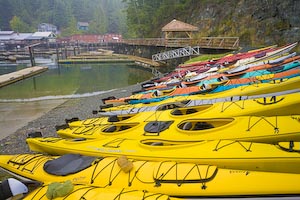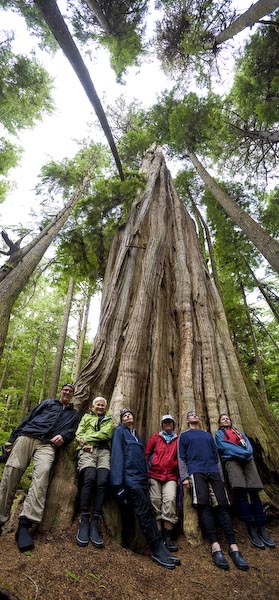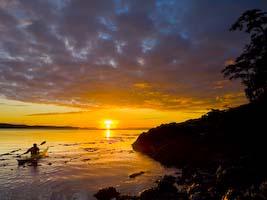On a guided trip with Sea Kayak Adventures, we kayak Johnstone Strait off Vancouver Island, British Columbia, Canada, to see Orca Whales.

September, 2008. Telegraph Cove, Vancouver Island, BC, Canada. The afternoon skies are a bright-overcast—photographer’s light—with just a wisp of a breeze that would make pulling the paddle through the tranquil water a joy if I were paying attention, but I’m not. Instead, I’m getting swivel neck from so many Orca passing by our raft of kayaks. I see—or hear—a spout, then twist to try to get a photo. Mostly I miss the peak of the action, but I have lots of chances so I’ve banked a few keepers. The one shot that I need, though—the money shot I don’t yet have—is a pod of Orcas surfacing in front of the kayak raft.
Kayakers head for the Johnstone Strait area of northern Vancouver Island to paddle with whales. On a guided trip with Sea Kayak Adventures, we launched at Telegraph Cove, and paddled east along the Vancouver Island shore and into an area thick with Orca. Whales ply the shore here looking for salmon, following the fish that make their fall return to natal streams. The whales also stop in at the Robson Bight Ecological Reserve— a protected watershed—where the whales love rubbing their bellies on the bay’s beach cobbles.

With hoards of kayakers here to view the whales, a code of conduct has evolved, to least disturb the whales, and for kayaker safety as well. When whales are sighted, kayakers are supposed to raft up, and then watch the show. As the Sea Kayak Adventure guides explained, the only exception to this is when kayakers are inside the kelp line that hugs the shore. Then paddlers are free to paddle singly—though it’s still wise to raft up—and whales should never be approached. Groups of whales—mostly females with their sisters and young—often closely follow the shoreline, so we’re in for a great show regardless. The bigger male pod members, with their six-foot dorsals, seem to favor waters farther out in Johnstone Strait.

Aside from the whales, the whole area is worthy of exploration. The day before we crossed Blackfish Sound, and then two-mile wide Johnstone, departing from a beautiful camp with a sunset view that gave us access to myriads of islets and waterways of the kind kayakers crave. While there the kayak gods ordered up our one truly Northwest rain day—a specialized drizzle with droplets so small they seem to float in the air and seep into our bones. It kept my camera in the dry box all day. Of course, we paddled anyway, meandering through a maze of passages made intimate by the ghostly emergence of each point of land as we glided along. Back in camp, we were served hot drinks and wine under a big tarp. Later, just as the guides sounded the dinner bell with Dutch-oven Lasagna, the horizon to the west began to clear—but with an artist’s array of clouds. I plopped a kayak in the water and raced to a point to get the only sunset shot of the trip.

With so many whales around the kayaks, I decide to point my lens at our rafted boats. I’m hanging close to the rocks, with the group raft near the kelp line. I open the zoom to 70mm wide, the better to see the shot, then lean forward and rest my elbows on the deck. I put the kayaks in the corner of the frame. Scarcely a minute later, a big female, followed by other pod members, surface in the viewfinder. I fire off a half-dozen money shots, all of them keepers.
Most whale-watching trips here start at Telegraph Cove, just east of Port McNeil. To join a trip with guides versed in natural history and excellent culinary skill, sign on for a five or six-day tour with Sea Kayak Adventures (www.seakayakadventures.com).










